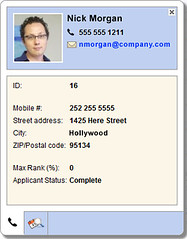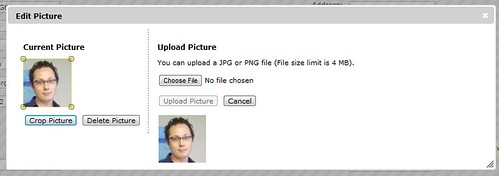What have I been working on at Taleo?
2011 has been a year of great clients for me. I started working with O.co and very much enjoyed my time there, especially on powder days in Utah. The people were great, the contract was great (no end date), but the work was not my forte. I was on a project to modularize the main shopping site's codebase, which involved mostly refactoring. By refactoring, I mean creating new Maven projects, modifying lots of pom.xml files and literally moving files from one directory to another. IntelliJ made this easy, the hard part was refactoring tests, moving from EasyMock to Mockito and splitting classes into interfaces and implementations where appropriate. As a developer who likes developing UIs and visually seeing my accomplishments, the project wasn't that exciting. However, I knew that it was strategically important to O.co, so I didn't complain much.
In mid-May, I received a LinkedIn message from the Director of Software Engineering at Taleo.
This is OB, I am the Director of Software Engineering at Taleo. We are the 2nd largest Software as a Service company. I am building a new specialist UI team that will take the product to the next level. I am looking for someone to lead this initiative. If you are interested to have a chat about it, please let me know.
At that time, I'd never heard of Taleo and quickly recommended they not hire me.
This probably isn't the best position for me. While I am a good leader, I'm not willing to relocate from Denver. I've found that leaders usually do best when face-to-face with their developers.
This conversation continued back-and-forth where I explained how I wasn't willing to go full-time and I didn't want to leave Overstock. In the end, OB was persistent and explained how the position would entail lots of UI work and wouldn't require me to travel much. Our negotiations trailed off in June and resumed in July after I returned from vacation in Montana. Shortly after, we met each other's expectations, agreed on a start date and I started working at Taleo in early September.
When I started, there were three features they wanted to add to to Taleo Business Edition: Profile Pictures, Talent Cards and Org Charts. They knew the schedule was tight (8 weeks), but I was confident I could make it happen. At first, I groaned at the fact that they were using Ant to build the project. Then I smiled when I learned they'd standardized on IntelliJ and set things up so you could do everything from the IDE. After using Maven for many years, this setup has actually become refreshing and I rarely have to restart or long for something like JRebel. Of course, a new kick-ass laptop and awesome IDE make it so I rarely wait for anything to happen.
To give you a taste of how I implemented each of these new features in 8 weeks, I've broken them into sections below.
Profile Pictures
Adding profile pictures was a pretty simple concept, one you see on my social networking sites today. I needed to give users the ability to upload a JPEG or PNG and crop it so it looked good. The uploading was a pretty straightforward process and I used a lot of internal APIs to grab the file from the request and save it to disk. The more difficult part was scaling the image to certain dimensions on upload (to save space) and allowing users to crop it after.
Most of Taleo Business Edition (TBE) is written in good ol' servlets and JSPs, with lots of scriptlets in their JSPs. When I saw the amount of HTML produced from Java, I laughed out loud and cringed. Soon after, I breathed a sigh of relief when I learned that any new features could be written using FreeMarker templates, which IntelliJ has excellent support for.
For image resizing on upload, I used Chris Campbell's Image.getScaledInstance() tutorial. For creating thumbnails, I used a combination of scaling, getSubimage() and the Java Image I/O API. I made sure to write to BufferedOutputStream for scalability. For cropping images client-side, I used jQuery UI's Dialog and Jcrop, the jQuery image cropping plugin. Below is a screenshot of what the cropping UI looks like:
Talent Cards
Talent Cards were a whole different beast. Not only did they need to display profile pictures, they also needed to contain contact information, work history and a number of other data points. Not just for employees, but for candidates as well.
They also needed to be rendered with tabs at the bottom that allowed you to navigate between different data sections.
 I'll admit, most of the hard work for this feature was done by the server-side developers (Harish and Vlad) on my team. Vlad built the tabbed interface and Harish built the administrative section that allows you to add/remove/sort fields, as well as show and hide certain tabs. I performed most of my magic with jQuery, its clueTip plugin and good ol' CSS. I was particularly thankful for CSS3 and its border-radius, box-shadow and Justin Maxwell's tutorial on CSS String Truncation with Ellipsis. I used DWR to fetch all the data from the server using Ajax.
I'll admit, most of the hard work for this feature was done by the server-side developers (Harish and Vlad) on my team. Vlad built the tabbed interface and Harish built the administrative section that allows you to add/remove/sort fields, as well as show and hide certain tabs. I performed most of my magic with jQuery, its clueTip plugin and good ol' CSS. I was particularly thankful for CSS3 and its border-radius, box-shadow and Justin Maxwell's tutorial on CSS String Truncation with Ellipsis. I used DWR to fetch all the data from the server using Ajax.
Talent Cards are a slick feature in TBE 11.5 and I think they're a great way to see a lot of information about someone very quickly. If you enable them for your company, you'll be able to mouse over any employee or candidate's names and see their information.
Org Chart
The last feature I completed in this 8-week sprint was creating an organization chart. For this, I was given a rough prototype based on Caprica Software's JQuery/CSS Organisation Chart. When I received it, it had all kinds of cool CSS 3 transformations (like this one), but they only worked in Safari and Chrome. I ended up removing the transformations and adding the ability to navigate up and down the org tree with Ajax (we currently only show three levels at a time).
The Org Chart feature also allows you to see how many direct/indirect reports an employee has, as well as access their Talent Card by hovering over their name. It's one of my favorite features because it's so visual and because it builds upon all the other features we've built.
Summary
As you might've guessed by now, I've been having a lot of fun doing UI development over the last few months. While I seem to have a knack for backend Java development, I enjoy developing UIs a lot more. The smile you see on people's faces during demos is priceless. I can't help but think this kind of thing contributes greatly to my developer happiness. All these features will be in next week's release of TBE and I couldn't be happier.
If you'd like to work on my team at Taleo (or even take over my current role as UI Architect), please drop me a line. If you live near their headquarters (Dublin, CA), it'd also be great to see you at the next Silicon Valley Spring User Group meetup. I'll be speaking about What's New in Spring 3.1 on February 1st.



